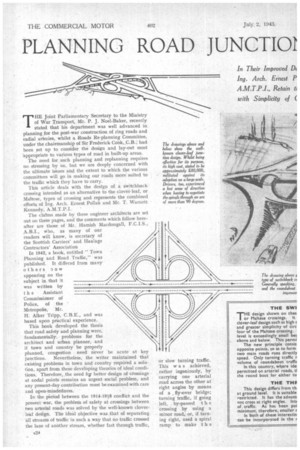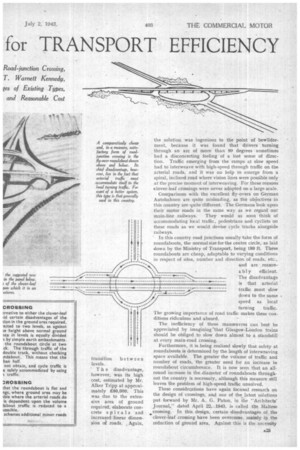PLANNING ROAD JUNCTIOT
Page 26

Page 27

Page 28

If you've noticed an error in this article please click here to report it so we can fix it.
for TRANSPORT EFFICIENCY THE Joint Parliamentary Secretary to the Ministry of War Transport, Mr. P. J. Noel-Baker, recently stated that his department was well advanced in planning for the post-war construction of ring roads and radial arteries, whilst a Roads Re-planning Committee, under the chairmanship of Sir Frederick CoOk,,C.B., had been set up to consider the design and lay-out most appropriate to various types of road in built-up areas.
The need for such planning and replanning requires no stressing by us, but we are deeply concerned with the ultimate issues and the extent to which the various committees will go in making our roads more suited to the traffic which they have to carry.
This article deals with the design of a switchback crossing intended as an alternative to the clover-leaf, or Maltese, types of crossing and represents the combined efforts of Ing. Arch. Ernest Pollak and Mr. T. Warnett Kennedy, A.M.T.P.I. '
The clears made by these engineer architects are set out on these pages, and the comments which follow hereafter are those of Mr. Hamish Macdougall, F.C.I.S., A.B.I., who, as many of our readers will know, is secretary of the Scottish Carriers and Haulage Contractors' Association
In 1942, a book, entitled "Town Planning and Road Traffic," was published. It differed from many others. low
appearing on the subject in that it was written by --..--/..
t h e Assistant --41-
Commissioner of Police, of the Metropolis, Mr.
H: Alker Tripp, C.B.E., and was based upon practical experience.
This book developed the thesis that road safety and planning were, fundamentally, problems for the architect and urban planner, and if town and country be properly planned, congestion need never be acute at key junctions. Nevertheless, the writer maintained that existing problems in town and country required a solution, apart from these developing theories of ideal conditions. Therefore, the need fqr better design of crossings at nodal points remains an urgent social problem, and any present-day contribution must be examined with care and open-mindedness.
In the period between the 1914-1918 conflict and the present war, the problem of safety at crossings between two arterial roads was solved by the well-known cloverleaf design. The ideal objective was that of separating all streams of traffic in such a way that no traffic crossed the lane of another stream, whether fast through traffic, or slow turning traffic. This w a s achieved, rather ingeniously, by carrying one arterial road across the other at right angles by means of a fly-over bridge; turning traffic, if going left, by-passed t h e crossing by using a minor road or, if turning right, used a spiral ramp to make t h e transition be levels.
' T h e disadvantage, however, was its high cost, estimated by Mr. AIker Tripp at approximately £80,000. This was due to the extensive area of ground required, elaborate concrete spirals and increased linear dimension of roads. Again,
the solution was ingenious to the point of bewilderment, because it was found that drivers turning through an arc of more than 90 degrees sometimes had a disconcerting feeling of a lost sense of direction. Traffic emerging from the ramps at slow speed had to interweave with high-speed through traffic on the arterial roads, and it was no help to emerge from a spiral, inclined road where vision lines were possible only at the precise moment of interweaving. For these reasons clover-leaf crossings were never adopted on a large scale.
Comparisons with the excellent fly-overs on German Autobahnen are quite misleading, as the objectives in this country are quite different. The Germans look upon their motor roads in the same way as we regard our main-line railways. They would as soon think of accommodating local traffic, pedestrians and cyclists on these roads as we would devise cycle tracks alongside railways.
In this country road junctions usually take the form of roundabouts, the normal size for the centre circle, as laid 4/own by the Ministry of Transport, being 180 ft. These roundabouts are cheap, adaptable to varying conditions in respect of sites, number and direction of roads, etc., and are reasonably efficient. The disadvantage is that arterial
traffic must slow down to the same speed as local turning traffic. The growing importance of road traffic makes these conditions ridiculous and absurd.
The inefficiency of these manceuvres can best be appreciated by imagining 'that Glasgow-London trains should be obliged to slow down almost to a standstill at every main-road crossing.
Furthermore, it is being realized slowly that safety at roundabouts is determined by the length of interweaving space available. The greater the volume of traffic and number of roads, the greater need for an increase in roundabout circumference. It is now seen that an allround increase in the diameter of roundabouts throughout the country is necessary, although this measure still leaves the problem of high-speed traffic unsolved.
These considerations have again focused research on the design of crossings, and one of the latest solutions put forward by Mr. A. G. Paton, in the "Architects' Journal," dated April 22, 1943, is called the Maltese crossing. In this design, certain disadvantages of the clover-leaf crossing have been overcome, mainly in the reduction of ground area. Against this is the necessity
of four levels for separating traffic streams, and elaborate concrete superstructures to support the roadways.
It would appear that Messrs. Pollak and Kennedy have carried this research a stage farther by retaining the advantages and ideal objectives of other designs, in their extremely simple two-level switchback crossing _ and the three-level crossing. For the first time the fly-over and roundabout have been incorporated in the same design, although Mr. Alker Tripp approximated to the idea in his diagram showing a roundabout with one fly-over. In the three-level crossing, this has logically been carried a stage farther to achieve total ad vantages.
The switchback crossing is more flexible than either the clover-leaf or Maltese designs, where a right-angle crossing is essential. In many cases, thismeans that arterial roads need to be curved for some distance back to ensure that the roads do meet at right angles, and further that large areas of ground must he acquired for this purpose.
Obviously, many. variations of the switchback and three-level crossings are possible, depending upon site conditions, existing road levels and other specific factors. Nevertheless, it appears that the gap between expensive arterial crossings on the old model and the typical, con
ventional roundabout with its grave limitations, has been bridged.
If further inquiry and tangible experiment proves the efficacy of these practical and imaginative designs, it may well be that a great public need has been satisfied. The implications contained in the widespread use of such devices will have wide repercussions in the fields of townplanning and transport. The whole question of national planning of trunk roads will be seen in a new light, and added weight and impetus will be given to the movement towards intelligent planning for road_ transport, the contribution of which to the Nation, both in taxes and in efficiency, deserves the best that can be designed in the interests of safety, and essential and speedy distribution.




















































